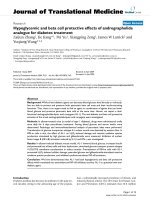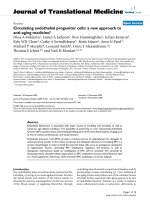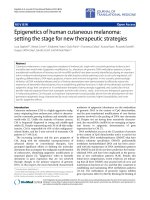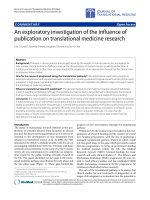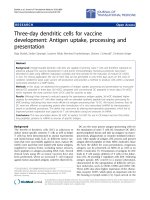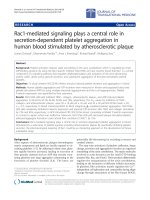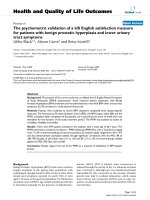báo cáo hóa học:" Modified femoral pressuriser generates a longer lasting high pressure during cement pressurisation" pot
Bạn đang xem bản rút gọn của tài liệu. Xem và tải ngay bản đầy đủ của tài liệu tại đây (1.15 MB, 6 trang )
RESEARCH ARTIC LE Open Access
Modified femoral pressuriser generates a longer
lasting high pressure during cement pressurisation
Jian-Sheng Wang
1,2*
, Göran Garellick
3
, Fred Kjellson
2
, Elizabeth Tanner
2,4
and Gunnar Flivik
1,2
Abstract
Background: The strength of the cement-bone interface in hip arthroplasty is strongly related to cement
penetration into the bone. A modified femoral pressuriser has been investigated, designed for closer fitting into
the femoral opening to generate higher and more constant cement pressure compared to a commercial
(conventional) design.
Methods: Femoral cementation was performed in 10 Sawbones
®
models, five using the modified pressuriser and
five using a current commercial pressuriser as a control. Pressure during the cementation was recorded at the
proximal and distal regions of the femoral implant. The peak pressure and the pressure-time curves were analysed
by student’s t-test and Two way ANOVA.
Results: The modified pressuriser showed significantly and substantially longer durations at higher cementation
pressures and slightly, although not statistically, higher peak pressures compared to the conventional pressuriser.
The modified pressuriser also produced more controlled cement leakage.
Conclusion: The modified pressuriser generates longer higher pressure durations in the femoral model. This design
modification may enhance cement penetration into cancellous bone and could impr ove femoral cementation.
Keywords: Pressuriser, pressurisation, THA and cementing technique
Background
Since 1979 th e Swedish Hip Arthroplasty Register has
documented improvements in cementing techniques.
Changes in the “Modern Cementing Technique” have
been linked to at least 20% reduction in revision rates for
aseptic loosening [1]. The strength of the cement-bone
interface is strongly related to cement intrusion into the
bone [2]. The shear strength of the cement-bone interface
has been investigated since the 1970’s. Studies showed
that maximal cement-bone interface shear strength is
related to thoroughly cleaned strong trabecular bone with
a deep cement penetration [3]. Buckley et al. [4] showed
that bone cement interdigitated into cancellous bone was
better able to resist fracture than bone cement alone. The
depth of cement intrusion c orrelates with the cement-
intrusion pressure [5-10]. High and constant pressure,
both to resist the force of blood pressure and to force the
cement into the spaces in the cancellous bone, is necessary
during cement filling. The purpose is to reach extensive
micro-interlock [11-14]. Therefore, increasing cement
pressurisation and duration is an essential component of
cementing to ensure good cement-bone contact through-
out the femoral cavity, radiographic “whitening out” and a
stronger bone-cement interface.
The aim of a proximal femoral seal is to keep the femur
closed while the cement is injected and thereby provide
high cementation pressure resulting in better cement
penetration. Some cement leakage always occurs from
the proximal femur even when using a pressuriser and
this leakage lowers the pressure generate d in the femoral
canal and thus cement penetration into cancellous bone
[15]. As we found many existing commercial pressurizers
allow too much cement leakage during pressurisation, we
designed a modified femoral pressuriser, trying better to
acco unt for the anatomi c proximal femoral contour. The
new design was based on a combination of multiple mea-
surements from templating total hip arthroplasties at our
hospital and the involved surgeons’ clinical experience.
* Correspondence:
1
Department of Orthopedics, Clinical Sciences Lund, Lund University and
Skåne University Hospital, Lund, S-221 85, Sweden
Full list of author information is available at the end of the article
Wang et al. Journal of Orthopaedic Surgery and Research 2011, 6:54
/>© 2011 Wang et al; licensee BioMed Central Ltd. This is an Open Access article distributed under the terms of the Creative Commons
Attribution License (http://creativecommo ns.org/licenses/by/2.0), which permits unrestricted use, distribution, and reproduction in
any medium, provided the original work is properly cited.
The aim was to improve the proximal seal and thus to
achieve higher and more constant pressure in the femoral
canal with reduced and more controlled leakage. This
new design of pressuriser was investigated using Saw-
bones
®
model proximal femora and the results compared
to a conventional pressuriser.
Materials and methods
The conventional pressuriser was provided by Biomet
Cementing Technologies AB (Sjöbo, Sweden). The modi-
fied pressuriser was made longer in the proximal-distal
direction and narrower in the anterior-posterior and med-
ial-lateral directions with a narrower taper angle compared
to the conventional design (Figure 1 and Table 1). The
modified pressuriser was made of the same silicone mate-
rial as the conventional and both designs were reinforced
with a newly developed 2 mm thick steel backing plate
(Figur e 2) whi ch aimed at assisting in load transfer from
the cement gun.
Ten Sawbones
®
proximal femora were prepared based
on standard operative procedures. The femoral neck
osteotomy was standardised to a cut at 20 mm from the
lesser trochanter. The femoral canal was reamed to fit a
Biomet Optima
®
femoral prosthesis allowing for 3 mm
cement mantle. A distal plug (Optiplug, Biomet Cement-
ing Technologies AB) was inserted into the canal, to pro-
vide a 10 mm p rosthesis distal t ip to plug dis tance. To
measure the cement pressure two modified Entran EPB-
B02 pressure transducers (Entran, UK) were inserted and
fixed into drill holes made on the lateral femoral shaft
(Figure 2). The positions were standardised at 50 mm
(position 1) and 140 mm (position 2) from the tip of the
greater trochanter.
80 g of pre-chilled (4°C) Palacos R was mixed using an
Optivac
®
cement mixing s ystem (Biomet Cementing
Technologies AB, Sjöbo, Sweden) under vacuum (0.15
bar) in a temperature controlled room at 21 ± 1°C. At 2
minutes 15 seconds after start of mixing, the cement was
injected in a retrograde manner into the Sawbones
®
model bone using a cement gun (Optigun, Biomet
Cement ing Technologies AB, S jöbo, Sweden) with a long
nozzle. Immediately after the end of cement injection a
pressuriser, reinforced with the metal backing plate, was
placed on to the nozzle which was cut close to the end of
the pressuriser. The cement gun was placed on the calcar
opening on the proximal femur and load was applied
from 2 min and 45 seconds to 4 minutes 30 seconds after
the start of cement mixing using as standard manner as
possible, with gradual injection of additional cement. The
leakage of the cement was observed and the manner of
Figure 1 Two types of cement pressurisers. Conventional pressuriser on left side and modified pressuriser on right side.
Table 1 The geometrical differences between the two
pressurisers
Pressuriser Proximal level Distal level Height
Width Thickness Width Thickness
Conventional 62 mm 28 mm 25 mm 13 mm 26 mm
Modified 47 mm 31 mm 28 mm 15 mm 37 mm
Wang et al. Journal of Orthopaedic Surgery and Research 2011, 6:54
/>Page 2 of 6
leakage noted. Use of the conventional or modified pres-
suriser was alternated. In total five modified pressurisers,
with five conventional ones as controls, were used in the
study. The Sawbones
®
preparation and subsequent pres-
surization procedure were performed by two experienced
hip surgeons in cooperation (GG and GF).
The pressure-time curves were recorded throughout
the cementation procedure. The peak pressure and time
durations when different pressure thresholds were
exceeded (100, 150, 200, 250 and 300 kPa) were ana-
lysed. Statistic analysis was performed using stud ent’st-
test for peak pressure and Two-way ANOVA for time
over these pressure thresholds.
Results
Using the modified pressuriser the cement tended to leak
from only one zone around the modified pressuriser (the
notch in the lateral-posterior region) whereas leakage
occurred from all zones around the convention al pres-
surisers (Figure 3). For the pressure time durations when
the cement pressure was above the thresholds, the differ-
ences between positions 1 and 2 were minimal within
each pressuriser group. However, with the modified pres-
suriser these durations were significantly longer than
with the conv entional design in every pressure point
(Two way ANOVA with Bonferroni/Dunn test, p <
0.0005, Figure 4).
The mean peak pressure at position 1 r eached 339.8 ±
68.1 kPa and 290.8 ± 29.6 kPa, and at po siti on 2 reached
343 ± 59.6 kPa and 294 ± 23.7 kPa for the modified and
conventional designs, respectively (Figure 4). For each
pressuriser design group the differenc e in cement pres-
sure between positions 1 and 2 was minimal (Modified
group p = 0.93; Conventional group p = 0.86). Compar-
ing the new modified with the conventional pressuriser,
an increase of 17% was seen for the new design, this dif-
ference was, however, not statistically significant (posi-
tion 1, p = 0.18 and position 2 p = 0.12, Figure 5).
Discussion
The modified pressuriser generates longer high pressure
durations in the femoral model. The pressure was homo-
genous within the femoral cavity for both p ressurisers.
Increases in cement pressurisation lead to increased
cement penetration [6,7,11-16] while constant high pres-
sure benefits high viscosity cement penetration whether
in a constrained cavity such as the femur [17] or a more
open area such as the acetabulum [18].
The conventional pressuriser tested here can reach a
high pressure, nearly 300 kPa (2256 mmHg), but due to
cement leakage did not retain this pressure. The changes
of pressures depend of how the pressurisers close t he
proximal calcar part. The longer taper and smaller circum-
ference of the modified design allows it to sink 5 to 6 mm
deeper into the proximal femur resulting in an improved
seal with the irregular surface of the resected femoral
neck. With more controlled and reduced cement leakage
the pressure drops more gradually allowing the high pres-
sure to be retained for longer. The time with high cemen-
tation pressure (250 kPa) was about twice that in the
modified pressuriser group, whereas in the lower pressure
thresholds (100-150 kPa) they were increased by about
one third (Figure 4). In an FEA model of cement penetra-
tion into the proximal femur it was shown that increasing
the pressure by 25% or 50% increased the cement volume
in the femur by 17% or 40% respectively, while increasing
the pressurisation time by 27% increased the cement
volume by 7.5%. It may be that as the modified pressuriser
sits slightly deeper in the proximal femur it will cover a
small region of the cancellous bone in the most proximal
Figure 2 The pressure transducers fixed within the Sawbone
®
model proximal femora and showing the more gradual taper of the
conventional design (left) compared to the modified design (right). With both pressurisers a newly developed metal backing plate was
used to support the pressuriser.
Wang et al. Journal of Orthopaedic Surgery and Research 2011, 6:54
/>Page 3 of 6
part of the femur, a concern we believe is negligible com-
pared to the better controlled pressurisation. Another risk
when increasing the femoral cementation pressure is
increased risk of fat and bone marrow emboli entering the
blood stream. This consideration emphasizes that when
using cement pressurisation it is mandatory to use careful
pulse lavage of the femoral canal and thoroughl y remove
marrow debris prior to the insertion of the cement. As
always the patient should be monitored during cement
insertion, pressurisation and stem insertion.
Although Sawbones are not identical to real bones
they have the advantage of the same basic geometry and
therefore the relative pressure distribution should be the
same even if there are minor chan ges produced by flow
in to the trabecular space. The study shows that this
new design of pressuriser works well in the standardized
Sawbone
®
model. The new pressuriser has, however,
also been used clinically in further trials with so far full
satisfaction, even if the effect of longer higher pressure
durationsisnotprovenforallpossiblevariationsof
femurs.
With both pressurisers a newly de veloped metal back-
ing plate (Figure 2) was used to support the pressuriser.
We believe that the use of the metal backing plate rather
than the s urgeon’ s fingers to support the pressuriser
makes the cementation procedure easier and provides a
Figure 3 During the pressurisation the cement leaked more arou nd the conventional pressuriser (le ft) compared to the modified
pressuriser (right).
0
20
40
60
80
100
120
140
100 150 200 250 300
kPa
Pressureduration(seconds )
MͲPͲ1
CͲPͲ1
MͲPͲ2
CͲPͲ2
Figure 4 The mean durations of the different pressures generated in the femoral canal with modified (blue lines) and convent ional
pressurisers (red lines) at positions 1 and 2. M-P-1 = Modified position 1 - Proximal. M-P-2 = Modified position 2 - Distal. C-P-1 =
Conventional position 1 - Proximal. C-P-2 = Conventional position 2 - Distal
Wang et al. Journal of Orthopaedic Surgery and Research 2011, 6:54
/>Page 4 of 6
better pressure transfer from the cement gun to the pres-
suriser, something that is probably t rue for all silicone
pressuriser designs.
Conclusions
It is possible to achieve a more controlled and longer
lasting high cementation pressure in femur with a pres-
suriser that better seals the femoral opening. This design
modification may enhance cement penetration into can-
cellous bone and make it easier to achieve radiographi-
cal “whitening out” when cementing a proximal femoral
component.
Acknowledgements
The authors would like to thank the Biomet Cementing Technologies AB,
Sjöbo, Sweden for providing of cement and cementing accessories for the
study.
Financial support: The study was supported Swedish Medical Research
Council (9509) and the Faculty of Medicine, Lund University.
Author details
1
Department of Orthopedics, Clinical Sciences Lund, Lund University and
Skåne University Hospital, Lund, S-221 85, Sweden.
2
Biomaterials and
Biomechanics Unit, Lund University, Lund, S-22185, Sweden.
3
Department of
Orthopaedics, Institute of Surgical Science, Sahlgrenska University Hospital,
Göteborg University, Mölndal, Sweden.
4
School of Engineering, University of
Glasgow, Glasgow, G12 8QQ, UK.
Authors’ contributions
JSW, GF and GG designed the study, performed the experiment, did the
data analysis and wrote the manuscript. KET was involved in study design
and writing the manuscript. FK took part in the performance of the
experiment. All authors read and approved the final manuscript.
Competing interests
The authors declare that they have no competing interests.
Received: 5 February 2011 Accepted: 17 October 2011
Published: 17 October 2011
References
1. Herberts P, Malchau H: How outcome studies have changed total hip
arthroplasty practices in Sweden. Clin Orthop 1997, 344 :44-60.
2. MacDonald W, Swarts E, Beaver R: Penetration and shear-strength of
cement bone interfaces in vivo. Clin Orthop Relat Res 1993, 286:283-288.
3. Halawa M, Lee AJ, Ling RS, Vangala SS: Shear strength of trabecular bone
from the femur, and some factors affecting the shear strength of the
cement-bone interface. Arch Orthop Trauma Surg 1978, 92(1):19-30.
4. Buckley PJ, Orr JF, Revie IC, Breusch SJ, Dunne NJ: Fracture characteristics
of acrylic bone cement-bone composites. proceedings of the Institution of
Mechanical Engineers part H: Journal of Engineering in Medicine 2003, 217-
H:419-427.
5. Davies JP, Harris WH: In vitro and in vivo studies of pressurization of
femoral cement in total hip arthroplasty. J Arthroplasty 1993, 8:585-591.
6. Juliusson R, Flivik G, Nilsson J, Ryd L, Onnerfält R: Circulating blood
diminishes cement penetration into cancellous bone. In vivo studies of
21 arthrotic femoral heads. Acta Orthop Scand 1995, 66:234-238.
7. Panjabi MM, Goel VK, Drinker H, Wong J, Kamire G, Walter SD: Effect of
pressurization on methylmethacrylate-bone interdigitation: an in vitro
study of canine femora. J Biomech 1983, 16:473-480.
8. Askew MJ, Steege JW, Lewis JL, Ranieri JR, Wixson RL: Effect of cement
pressure and bone strength on polymethylmethacrylate fixation. J
Orthop Res 1984, 1:412-20.
9. Frei H, Gadala MS, Masri BA, Duncan CP, Oxland TR: Cement flow during
impaction allografting: a finite element analysis. J Biomech 2006,
39:493-502.
10. Wadia F, Malik MHA, Leonard D, Porter ML: Cement pressurisation in the
acetabulum. International Orthopaedics (SICOT) 2006, 30:237-242.
11. McCaskie AW, Gregg PJ: Femoral cementing technique: current trends
and future developments. J Bone Joint Surg Br 1994, 76-B:176-7.
12. New AMR, Northmore-Ball MD, Tanner KE, Cheah SK: In vivo Measurement
of Acetabular Cement Pressurisation using a Simple New Design of
Cement Pressuriser. Journal of Arthroplasty 1999, 14:854-859.
13. Flivik G, Wulff K, Sandfridsson J, Ryd L: Improved cement pressurisation
gives better cement penetration. In vivo measurements during total hip
replacement. J Arthroplasty
2004, 19:911-918.
14.
Abdulghani S, Wang JS, McCarthy I, Flivik G: The influence of initial
pressurisation and cup introduction time on the depth of cement
penetration in an acetabular model. Acta Orthop 2007, 78:333-339.
15. Waanders D, Janssen D, Mann KA, Verdonschot N: The mechanical effects
of different levels of cement penetration at the cement-bone interface. J
Biomech 2010, 43:1167-1175.
16. Rey RM Jr, Paiement GD, McGann WM, Jasty M, Harrigan TP, Burke DW,
Harris WH: A study of intrusion characteristics of low viscosity cement
0
100
200
300
400
MͲPͲ1CͲPͲ1MͲPͲ2CͲPͲ2
Peakpressure(kPa)
Figure 5 The peak pressures for positions 1 and 2 for the modified (blue bars) and conventional (red bars) pressuriser. M-P-1 = Modified
position 1 - Proximal. M-P-2 = Modified position 2 - Distal. C-P-1 = Conventional position 1 - Proximal. C-P-2 = Conventional position 2 - Distal
Wang et al. Journal of Orthopaedic Surgery and Research 2011, 6:54
/>Page 5 of 6
simplex P and Palacos cement in a bovine cancellous bone model. Clin
Orthop 1987, 215:272-278.
17. Dunne NJ, Orr JF, Beverland DE: Assessment of cement introduction and
pressurization techniques. Proc Inst Mech Eng H 2004, 218:11-25.
18. Parsch D, Diehm C, New AM, Schneider S, Breusch SJ: A new bleeding
model of the human acetabulum and a pilot comparison of 2 different
cement pressurizers. J Arthroplasty 2004, 19:381-386.
doi:10.1186/1749-799X-6-54
Cite this article as: Wang et al.: Modified femoral pressuriser generates a
longer lasting high pressure during cement pressurisation. Journal of
Orthopaedic Surgery and Research 2011 6:54.
Submit your next manuscript to BioMed Central
and take full advantage of:
• Convenient online submission
• Thorough peer review
• No space constraints or color figure charges
• Immediate publication on acceptance
• Inclusion in PubMed, CAS, Scopus and Google Scholar
• Research which is freely available for redistribution
Submit your manuscript at
www.biomedcentral.com/submit
Wang et al. Journal of Orthopaedic Surgery and Research 2011, 6:54
/>Page 6 of 6

